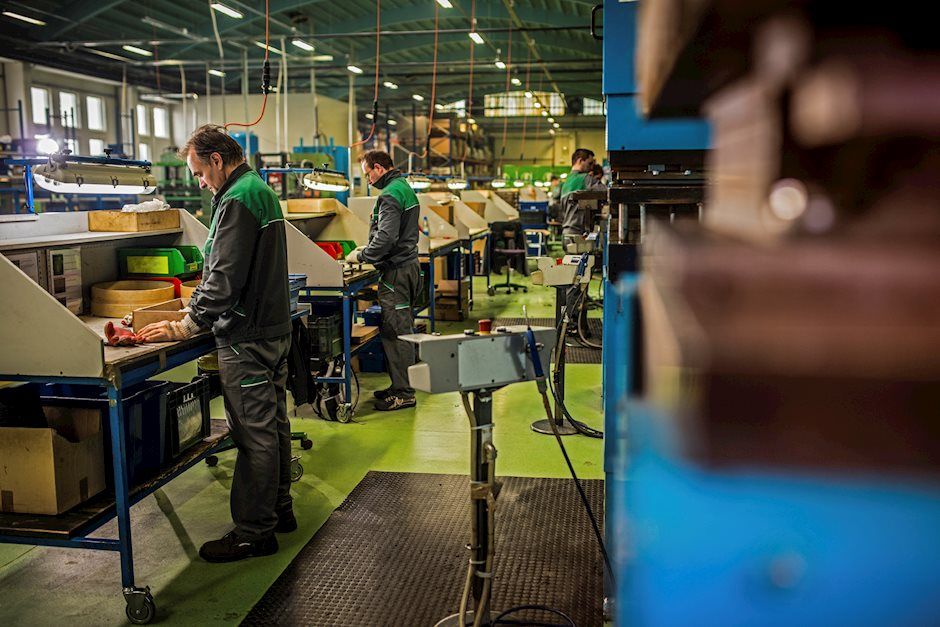Digitalised production chains are central to manufacturing’s productivity puzzle

Manufacturers must digitalise faster to stay competitive and be more sustainable. Accelerating the digitalisation of industrial production chains is also one of the ways to solve the industrial productivity puzzle.
Industry 4.0: The European manufacturing industry is lagging behind
The fourth industrial revolution, also referred to as Industry 4.0, is the next phase in the digitisation of the manufacturing sector, driven by interconnectivity, automation, and machine learning.
The European manufacturing industry is not yet halfway through this (r)evolution.
It is estimated that the majority of companies are roughly at the end of phase two of a recognised model that has six development phases (see below).
-
In phase two, isolated IT systems are interconnected and provide a representation of the core business processes.
-
Full integration between IT (information technologies) and OT (operative technologies) takes place in phase three of the model, in which processes are recorded from start to finish using sensors and made centrally monitorable in real time.
The next steps on the road to digital growth offer manufacturing companies more insight and speed of action. Lower failure costs, greater flexibility, a shorter time-to-market and increasingly autonomous operating processes will then be within reach.
-
A better understanding of interdependencies between processes brings the company into the transparency phase (four).
-
Then, in phase five, predictive skills allow the simulation of different future scenarios for timely anticipation and increased agility. Predictive maintenance is an example of using insights based on historical data, for example, about the wear of machine parts, whereby unintended downtime can be prevented through early (predictive) maintenance.
-
In phase six, such anticipation takes place fully automatically. This is only possible if the company knows how to use data in such a way that optimisation decisions are made autonomously using artificial intelligence.
Six phases of digital transformation
Source: ING Research based on Acatech
Digital technologies can make industrial business processes more efficient
The pursuit of a 'smart industry' has been widely embraced by policymakers and industry associations. Central to this is digital communication between companies and business units and processes. Digital technologies, such as smart software, robots and sensors, can make the design, manufacture and distribution of products more efficient. For example, via a shorter time-to-market through digital production simulations or via the optimisation of production processes by using an increasing amount of data to reduce machine downtime.
Industrial productivity is increasing structurally thanks to technological revolutions
Timeline of technological breakthroughs that increase industrial productivity.
Despite acceleration, industry is well behind the digital leaders
Digital transformation is accelerating in all sectors, and manufacturing is no exception. The share of companies with high digital intensity has increased faster than before the Covid-19 pandemic and the share of companies with very high digital intensity has increased even faster. The European industry has an average digital intensity that is slightly below the average of all sectors combined. However, the gap between leaders such as ICT, business services and wholesale is considerable.
Digital transformation goes beyond the invention of new technologies. Companies must absorb and apply the innovation, for which agility and a strong innovation culture are of great importance. When innovations from frontrunners are applied across industries, broad productivity effects occur. Research by Van Ark et al. suggests that digitalisation matured enough during the Covid-19 pandemic to ensure a long-term recovery in productivity growth.
Labour productivity growth in European industry is falling
Labour productivity growth has been slowing down globally for decades, including in the manufacturing industry.
Between 2017 and 2021, manufacturing in Europe became, on average, 1.7% more productive each year. Between 2007 and 2011, this figure was 2.5% and in the period 1997-2001 it was 4%.
Higher productivity growth is necessary to grow in times of an ageing population and a shrinking workforce. Technological applications have always been an important flywheel for productivity increases. In industry, with its repetitive, predictable and serial production processes, they are relatively easy to apply.
Productivity growth in manufacturing is relatively high, but slowing
Growth of real labour productivity per hour worked in the European Union
Source: ING Research based on Eurostat
Digitalisation has a delayed effect on productivity figures
The fourth industrial revolution is accompanied by a 'productivity paradox'. Sharply increased business spending on ICT and digital services has not yet led to faster productivity growth. Indeed, although digital technologies have spread rapidly in the economy, their adoption and translation into better business performance have been rather slow and uneven. Yet there is evidence that digitalisation improves productivity in the longer term.
Evidence of positive coherence at sector and firm level
Productivity appears to be positively related to the adoption of digital technologies at the sector and company level. In the US, sectors producing digital products and services are the largest contributors to productivity growth. In the eurozone and the UK, the most digitalised sectors do show higher productivity contributions. According to other research, digital adoption in an industry is related to productivity gains at the firm level. Effects appear to be relatively stronger for serial production processes and for the most productive companies, and weaker when digital skills are insufficiently developed.
Industry is rapidly becoming more digital, but is lagging behind the frontrunners
Source: ING Research based on Eurostat *based on the Digital Intensity Index **estimate due to missing figure
Read the original analysis: Digitalised production chains are central to manufacturing’s productivity puzzle
Author

ING Global Economics Team
ING Economic and Financial Analysis
From Trump to trade, FX to Brexit, ING’s global economists have it covered. Go to ING.com/THINK to stay a step ahead.





















